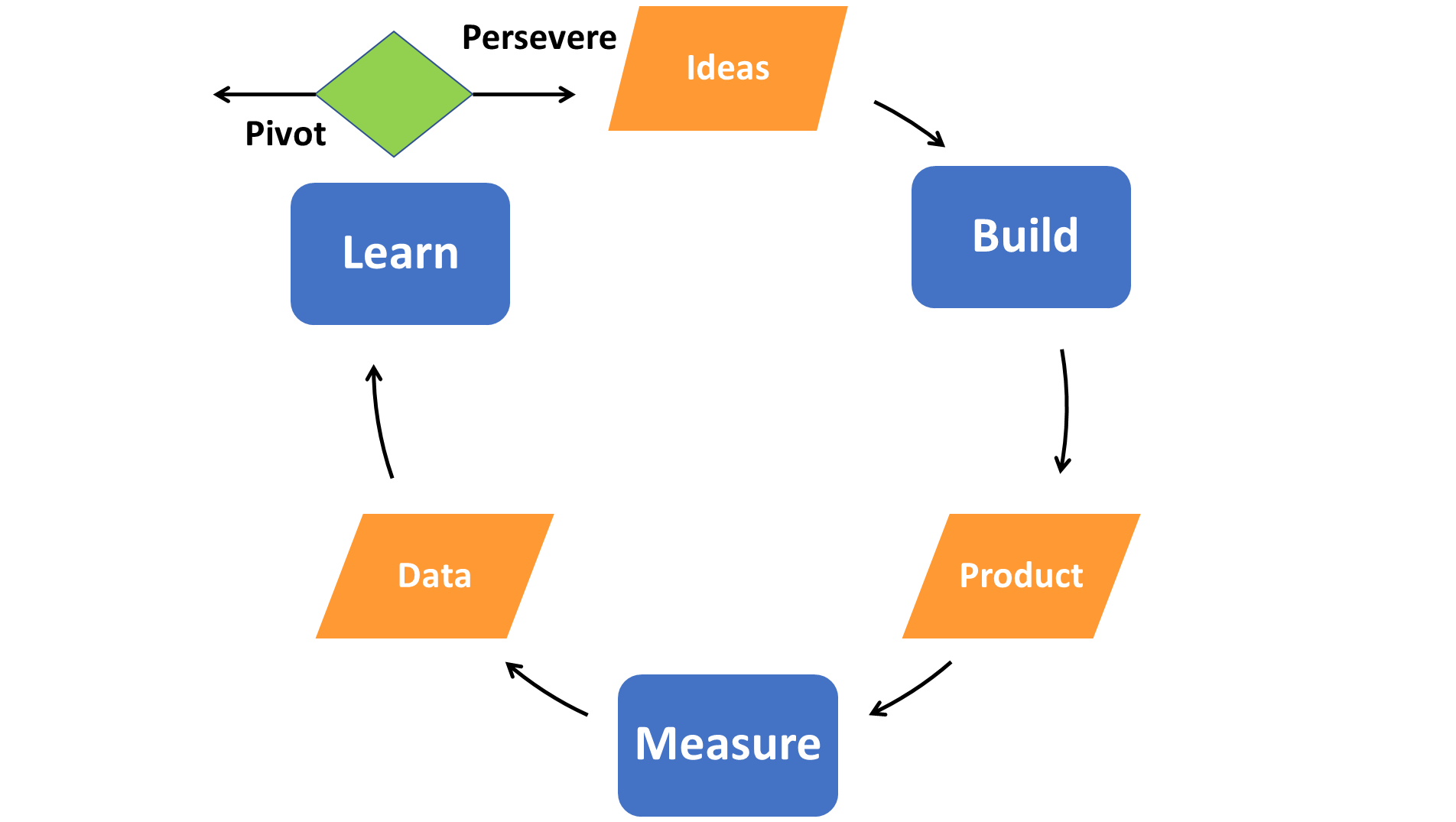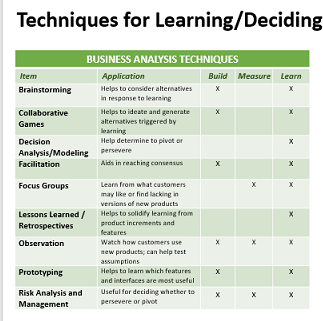
Why Agile isn’t Enough Part 4: Lean Startup Learn Phase and BA Techniques that Enhance it
In previous parts of this article, we covered an overview of Lean Startups and its Build-Measure-Learn (BML) methodology.
We also explored the Build portion of the cycle, the first step in a Lean Startup. Another article examined the Measure phase of the methodology, which can provide the measures to learn if our product is on the right track.
Lean Startup was created by Eric Ries and detailed in his seminal book The Lean Startup published in 2011. Lean Startup helps to guide product development, whether in established companies or startups. It is designed to shorten product development time, helping us deliver products and their features that customers need, not just what they tell us they need.
In this part we’ll examine the remaining portion of the B-M-L cycle, Learn.
LEARN
After building a product or features, the second part of the Lean Startup method is measuring how a product is adopted and used. That phase is covered in part 3 of this series. Metrics should be meaningful and should allow us to measure our learning and progress towards goals. Essentially, a Lean Startup grows when meaningful measurements are obtained and then “validated” to provide the learning needed. Validated metrics are those we can learn from to make needed additions, changes, and even “pivots,” which we’ll get back to.
Validated metrics are those we can learn from to make needed additions, changes, or even “pivots.”
3 Things to Learn
Learning is the key to a successful startup, whether that startup is a product or an entire company. Here are 3 important things we need to learn according to the Lean Startup method1:
- What customers really need and want, not just what they say they do (in Business Analysis, we constantly strive for that, right?).
- Which elements of our strategy are working (or not). That helps the team to maintain the strategy or modify it.
- Whether we’re on the right track to delivering a viable, sustainable product or business. If we are on the right track, we persevere; if not, we need to pivot.
And we’re not just talking about any old learning. We need any learning to be validated: backed by empirical data, which results in more useful truths and actionable information than traditional market forecasting or business planning. Validated learning is our best ally in testing and challenging assumptions and pre-conceptions.
Persevere or Pivot?
This question is perhaps the most important one for a Lean Startup. Returning to our B-M-L cycle again in Figure 2 we need to learn if our target metrics are moving our product towards the goals in the initial vision or not.
- If the metrics show we are moving toward the goals, then the startup can and should persevere.
- If the metrics are not moving us close enough to the target, we can design new experiments to test possible new features. Maybe we were testing the wrong thing. But failing that, or if we cannot generate new hypotheses, it is time to pivot – either by changing the product or to cancel it outright. I can attest that is a difficult decision having had to make it more than once.

Figure 2: Persevere or Pivot in Lean Startup
Advertisement
Examples of Pivots: The Importance of Learning
- Did you know that YouTube began as a video dating service with a slogan of “Tune in, hook up”? It did not grow as they had hoped until they discovered the appeal of a general video sharing service they are today.
- Groupon started as a platform for rallying people to social and charitable causes but started to fade after some initial success. They added a subdomain that pooled people together to receive discounts and that feature proved far more popular.
- In 2004 Yelp was a service where friends could ask each other for direct recommendations for things, which was not moving the company towards their goals. When they learned users were writing reviews for fun, they pivoted to focusing just on reviews that is their business today.
Learn/Decide – 9 Techniques
Besides the Business Analysis techniques to facilitate learning, I’m including techniques in Figure 3 to help with decision-making. That is because the “persevere or pivot” decision is the most important one a startup must make. Business Analysis skills such as facilitation can greatly assist during “pivot or persevere” meetings. Eric Ries suggests startups hold these roughly every month or two1. A suggested focus of these meetings is to review the relevant metrics against hypotheses and consider alternatives.

Figure 3: Techniques for Learning/Deciding
SUMMARY/KEY POINTS
In summary, we’ve seen several ways in which Business Analysis can help fuel a lean startup.
- Lean startup methodology relies on the Build-Measure-Learn cycle. It is focused on learning and delivering on what customers really need vs. what they say they do. What could be more important?
- Building – focus on finding “problems worth solving” and start by building an MVP, which is the fewest trips through the B-M-L cycle to build a product that provides the most validated learning.
- Measuring – valid measurements are the unsung heroes of a successful startup. Without valid measures we can’t learn as quickly or maybe not at all. Remember to avoid “Vanity Metrics” and collect “Metrics that Matter” using AAA metrics –Actionable, Accessible, and Auditable. They are essential to learning what customers need.
- Learning – is the acknowledged key to making Lean Startups succeed. We need to learn what customers really need and want, not what we think or what they tell us. We also use that learning to facilitate “persevere or pivot” sessions.
- Techniques – there are several proven, standard Business Analysis techniques that can help at every stage of the Build-Measure-Learn cycle. Not an exhaustive list to be sure, but we covered 20 of them and have a summary of the 20 as a free downloadable “template” available on https://www.watermarklearning.com/resources/templates.php.
Finally, if Build-Measure-Learn is the central engine driving a Lean Startup, then Business Analysis techniques and skills are the fuel for that engine. Accordingly, Lean Startups represent an exciting future for those of us who practice Business Analysis.
[1] Eric Ries, The Lean Startup: How Today’s Entrepreneurs Use Continuous Innovation to Create Radically Successful Businesses, New York: Crown Business Books, 2011
[1] 5 Big Brands That Had Massively Successful Pivots¸ Published February 15, 2018. Downloaded June 12, 2019. https://www.entrepreneur.com/article/308975